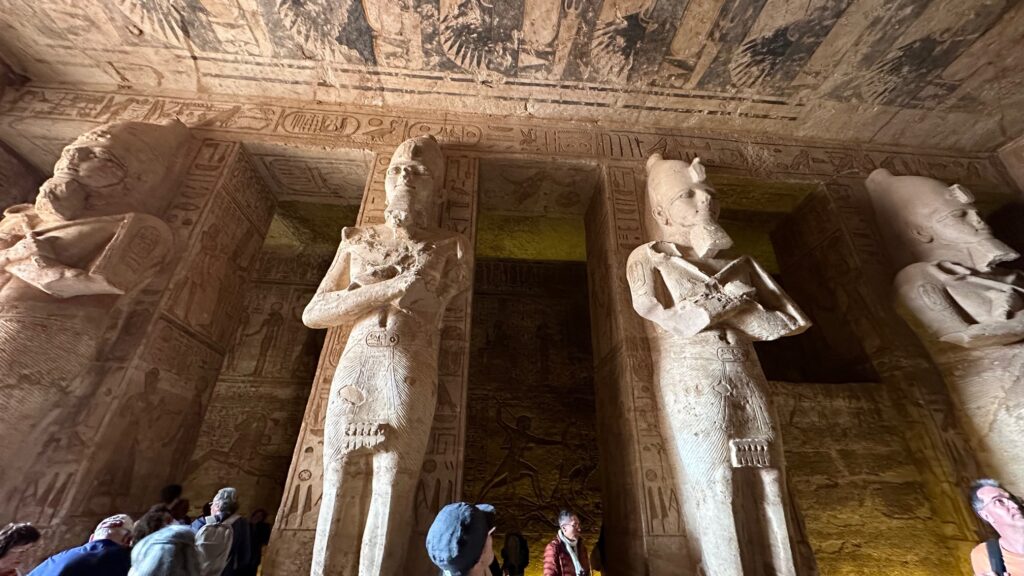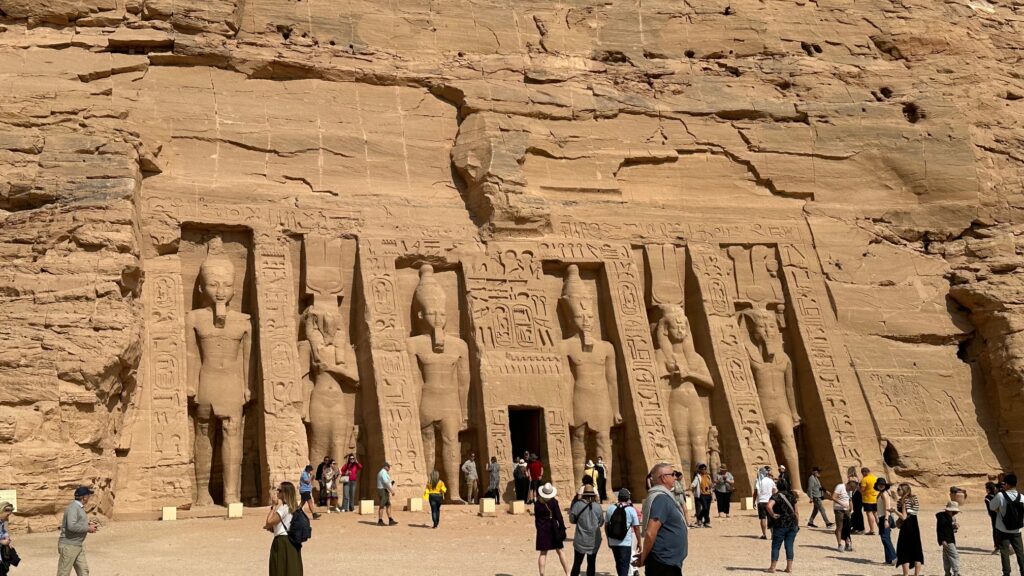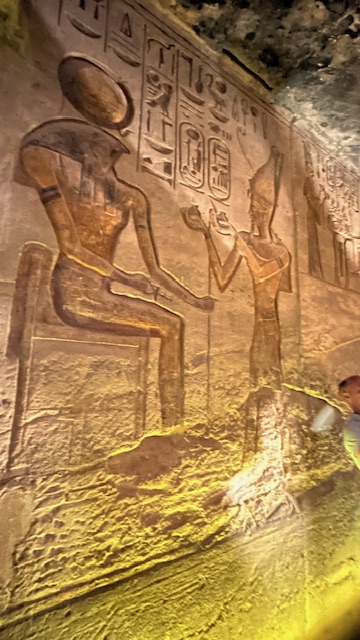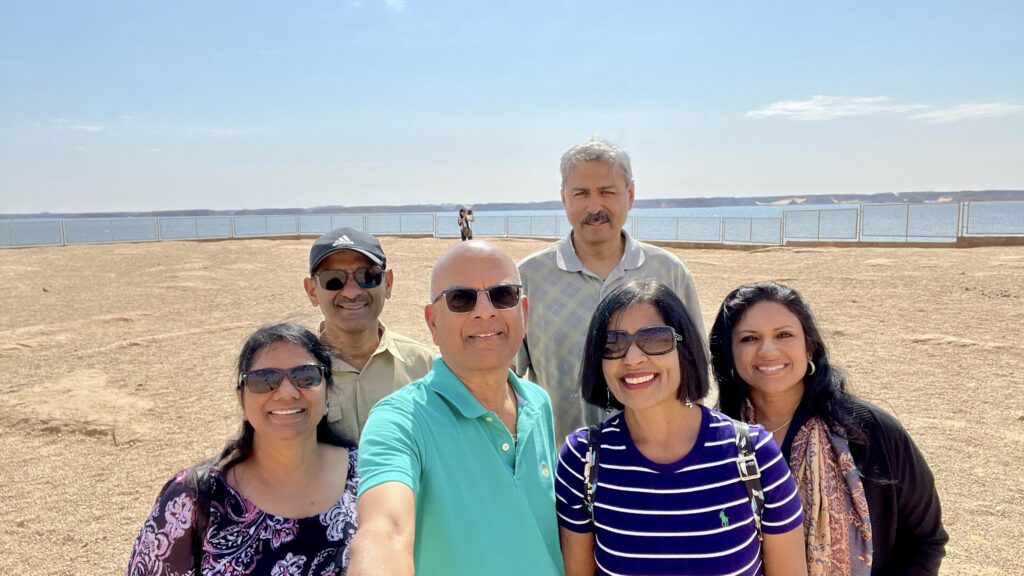We had to get up really early, as we were not only checking out of our cruise ship, but also driving to Abu Simbel, which was a three and half hour drive from Aswan. We reached Abu Simbel at 8:30am. The crowd was coming in as we parked the car. The inside of both temples were crowded with people and it was hard to get a picture without someone in the way.

Egyptians consider Abu Simbel to be one of its Seven Wonders. The archaeological site is comprised of two massive rock temples that were originally carved out of the mountainside during the reign of Pharaoh Ramesses II in the 13th century BC, as a lasting monument to himself and his Queen Nefertari. It took 20 years to build the temple and was dedicated to the gods Amun-Ra, Ra-Horakhti (Horus of 2 horizons), and Ptah, as well as the deified Ramesses himself. It is considered the grandest temples built during the reign of Ramesses II.
Relocation of Abu Simbel – In the early 1960s, when decisions were being made to build Aswan High dam, the rising waters of Lake Nasser (Aswan Dam reservoir) would have completely submerged Abu Simbel. To avoid this from happening, UNESCO conducted a major operation to move Abu Simbel in its entirety to higher grounds by the combined effort of over 50 countries and 5 years of work (1963-1968). Beginning in November 1963, a group of hydrologists, engineers, archaeologists and other professionals set out on UNESCO’s multi-year plan to break down both temples, cutting them into precise blocks (807 for the Great Temple, 235 for the smaller one) that were then numbered, carefully moved and restored to their original grandeur within a specially created mountain facade. Workers even recalculated the exact measurements needed to recreate the same solar alignment, assuring that twice a year, on about 22 February (the date of Ramses II’s ascension to the throne) and 22 October (his birthday), the rising sun would continue to shine through a narrow opening to illuminate the sculpted face of King Ramses II and those of two other statues deep inside the Great Temple’s interior. Finally, in September 1968, a colourful ceremony marked the project’s completion.

The Great Temple – Four colossal figures hewn from solid rock, guard the massive 33-meter-high facade of the temple. Sitting next to and between the legs of Ramesses are members of the royal family, including his beloved wife Nefertari, sons, daughters, and his mother. The broken statue was damaged in an earthquake and a portion of the statue sits on the ground in front of the façade. Seated on thrones, these 20-meter-high Colossi represent a deified Ramses II.

Hypostyle Hall: The Inner Temple – The grand entrance leads you into the huge Hypostyle Hall. Eight statues of Osiris, with the facial features of Ramesses II, fill the hall. The ceilings has paintings of flying vultures. The colors are fairly preserved. To the right and left of the Hypostyle Hall are eight small side chambers, some of which served as treasuries and store rooms.




The Sanctuary: House of the Gods – Located in the back of the temple, is the Sanctuary which contains the statues of deified Ramesses II, Ptah, Amon-Ra, and Ra-Horakhti. Twice a year, on February 22 and October 22, the first rays of the sun penetrate this room, lighting the sculptures along the back wall, except for Ptah, who is believed to be a god associated with the realms of death and who has always remained in darkness. Abu Simbel gets over crowded with people on these 2 days and there is a lot of pushing and shoving. These dates are said to be the coronation and birthday of the king Ramses II although this information is not supported by any evidence.

Temple of Hathor (Temple of Queen Nefertari) – To the north of the Great Temple of Ramses II is the Temple of Hathor (also known as the Small Temple of Abu Simbel). The temple was dedicated to Hathor, goddess of love, and to the deified Nefertari, Ramses’ wife. Six colossal 10-meter-high statues dominate the entrance facade depicting Ramses II and Queen Nefertari. Nefertari is reproduced twice as Hathor, with her cow horns, holding the solar disk on her head, while Ramses appears four times, with different crowns. Their children are represented in minor sizes beside their legs.



Temple of Hathor Hypostyle Hall – The entrance leads into an almost square Hypostyle Hall, the ceiling of which rests on six square columns, each surmounted by a head of the goddess Hathor. The images on the columns show Ramesses II and Nefertari presenting offerings to different gods and goddesses




The hypostyle hall is followed by a vestibule. Most of the reliefs on the walls here depict Nefertari and Ramses blessed by god, or making offerings to god.


Sanctuary – The small sanctuary with bas-reliefs on the side walls depicting scenes of offerings to various gods made either by the pharaoh or the queen. In this recess is a figure in high relief of the goddess Hathor as a cow; under her head (and thus under her protection) is Ramses II.

Group selfies….


We spent about 2 hours here after which we were dropped off at the Aswan airport, from where we took a flight to Cairo.
Most of the crowd visit Abu Simbel between 8:30am and 11am. The place empties out after 11:30am. If you don’t have to catch a flight or you have a late flight, it will be a good idea to visit the site after 11am.